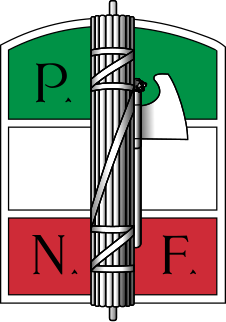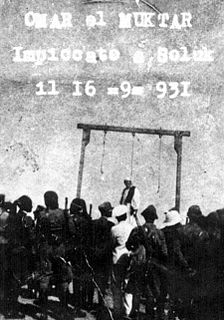
Marshal Pietro Badoglio, 1st Duke of Addis Abeba, 1st Marquess of Sabotino, was an Italian general during both World Wars and the first viceroy of Italian East Africa. With the fall of the Fascist regime in Italy, he became Prime Minister of Italy.

Italian Fascism, also known as Classical Fascism or simply Fascism, is the original fascist ideology as developed in Italy. The ideology is associated with a series of three political parties led by Benito Mussolini, namely the Revolutionary Fascist Party (PFR) founded in 1915, the succeeding National Fascist Party (PNF) which was renamed at the Third Fascist Congress on 7–10 November 1921 and ruled the Kingdom of Italy from 1922 until 1943 and the Republican Fascist Party that ruled the Italian Social Republic from 1943 to 1945. Italian Fascism is also associated with the post-war Italian Social Movement and subsequent Italian neo-fascist movements.
Squadrismo consisted of Italian fascist squads, mostly from rural areas, who were led by the ras from 1918–1924. As a movement, it grew from the inspiration many squadristi leaders found in Benito Mussolini, but was not directly controlled by Mussolini, and each squad tended to follow their own local leader. The squadrismo has been described as a “very undisciplined set of local bosses” where Mussolini attempted to assert some type of leadership control, although he had “not appointed” them nor had he usually met them. According to historian Stanley G. Payne, the "new mass Fascism had not been created by Mussolini," but the squadrismo had sprung up around him in rural areas, first starting in northern Italy.

The National Fascist Party was an Italian political party, created by Benito Mussolini as the political expression of fascism. The party ruled Italy from 1922 when Fascists took power with the March on Rome to 1943, when Mussolini was deposed by the Grand Council of Fascism.

Italian Libya was a colony of the Kingdom of Italy located in North Africa, in what is now modern Libya. Italian Libya was formed from the Italian colonies of Cyrenaica and Tripolitania that were taken by the Kingdom of Italy from the Ottoman Empire in 1911, during the Italo-Turkish War of 1911 to 1912. The unified colony was established in 1934 by governor Italo Balbo, with Tripoli as the capital.

The Italian colonial empire, known as the Italian Empire between 1936 and 1943, comprised the colonies, protectorates, concessions, dependencies and trust territories of the Kingdom of Italy. The genesis of the Italian colonial empire was the purchase in 1869 of Assab Bay on the Red Sea by an Italian navigation company which intended to establish a coaling station at the time the Suez Canal was being opened to navigation. This was taken over by the Italian government in 1882, becoming modern Italy's first overseas territory.

Propaganda of Fascist Italy was the material put forth by Italian Fascism to justify its authority and programs and encourage popular support.

The Soluch concentration camp was an Italian concentration camp in Suluq in the Italian colony of Libya during the Pacification of Libya that took place from 1928 to 1932. It was here that the famous Senussi anti-colonial rebel leader Omar Mukhtar was executed. The camp is recorded as having a population of 20,123 people.
The Marsa Brega concentration camp was an Italian concentration camp established in the village of Brega in the Italian colony of Libya during the Pacification of Libya that occurred from 1928 to 1932. The camp is recorded as having a population of 21,117 people.

The Sid Ahmed el Maghrun concentration camp was an Italian concentration camp established in El Magrun in the Italian colony of Libya during the Pacification of Libya that occurred from 1928 to 1932. The camp is recorded as having a population of 13,050 people.

The El Agheila concentration camp was an Italian concentration camp established in El Agheila in the Italian colony of Libya during the Pacification of Libya that occurred from 1928 to 1932. The camp is recorded as having a population of 10,900 people.
The Abyar concentration camp was an Italian concentration camp established in Abyar in the Italian colony of Libya during the Pacification of Libya that occurred from 1928 to 1932. The camp is recorded as having a population of 3,123 people.
The Agedabia concentration camp was an Italian concentration camp established in Ajdabiya in the Italian colony of Libya during the Pacification of Libya that occurred from 1928 to 1932. The camp is recorded as having a population of 10,000 people.
The Nocra prison camp was an Italian prison camp established for on the island of Nocra, off the coast of Massawa, in Italian colony of Eritrea, that was used to intern political prisoners.

The Arbegnoch were Ethiopian resistance fighters in Italian East Africa from 1936 until 1941. They were known to the Italians as shifta.
The Italian conquest of the Horn of Africa was initiated in 1924 by the fascist government of Italy under Benito Mussolini. With great brutality, Somalia had been totally pacified by late 1927. In 1935, Mussolini launched an invasion of Ethiopia. By mid-1936, the Italian troops controlled the entire territory. In 1940, Italian troops invaded British Somaliland, expelling the British. The Italians also occupied the bordering Kenya areas along the Oltregiuba, around the villages of Moyale and Buna.

Fascist Italy is the era of National Fascist Party government from 1922 to 1943 with Benito Mussolini as head of government of the Kingdom of Italy. The Italian Fascists imposed totalitarian rule and crushed political and intellectual opposition, while promoting economic modernization, traditional social values and a rapprochement with the Roman Catholic Church. According to Payne (1996), "[the] Fascist government passed through several relatively distinct phases". The first phase (1923–1925) was nominally a continuation of the parliamentary system, albeit with a "legally-organized executive dictatorship". The second phase (1925–1929) was "the construction of the Fascist dictatorship proper". The third phase (1929–1934) was with less activism. The fourth phase (1935–1940) was characterized by an aggressive foreign policy: Second Italo-Ethiopian War, which was launched from Eritrea and Somaliland; confrontations with the League of Nations, leading to sanctions; growing economic autarky; invasion of Albania; and the signing of the Pact of Steel. The fifth phase (1940–1943) was World War II itself which ended in military defeat, while the sixth and final phase (1943–1945) was the rump Salò Government under German control.










